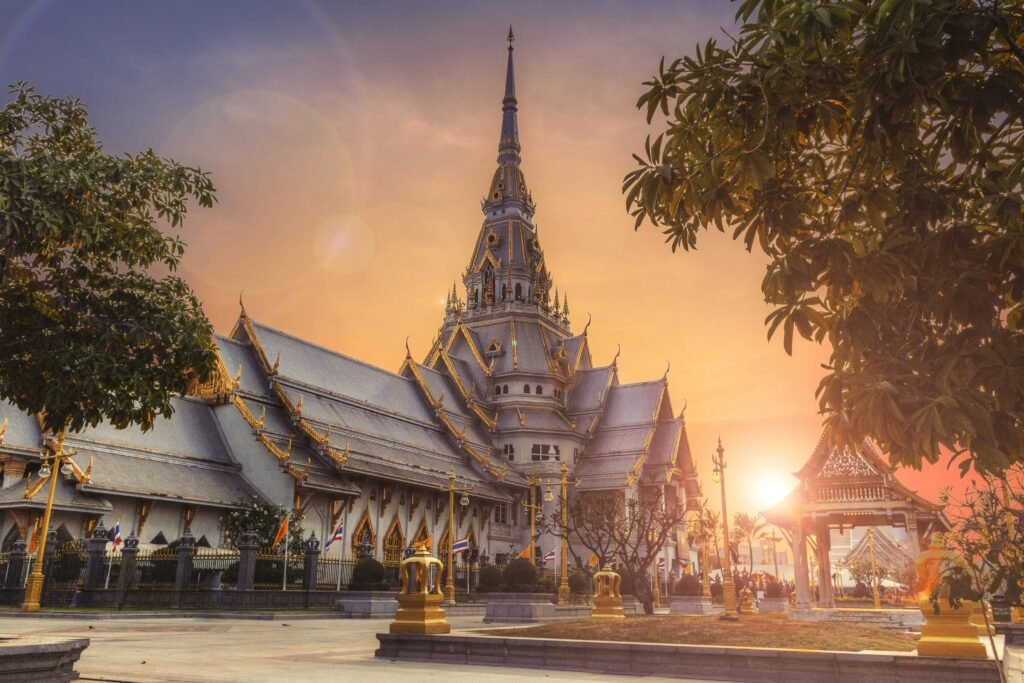
Greetings, travelers !
Are you craving the Fun sight of turquoise waters caressing pristine beaches, or do the lively energy of bustling markets and ancient temples beckon you?
If Thailand, also known as the “land of smiles,” has sparked your wanderlust, you’ve stumbled across the perfect guide!
In this blog post, you’ll find everything you need to create the ultimate Thai adventure, tailored to your specific travel desires. Whether you’re a seasoned traveler or a first-timer, we’ll unveil the magic of Thailand, from its cultural treasures to its exhilarating escapades.
Thailand is renowned for its gorgeous beaches, lively nightlife, and delectable cuisine, but behind the touristy facade lies a fascinating culture, steeped in ancient traditions, spiritual beliefs, and a deep respect for courtesy. Join us on a Travel journey to explore the heart and soul of Thailand.
Polite Greetings:
The Wai is a graceful gesture with profound cultural significance and is a fundamental aspect of Thai etiquette. It’s a beautiful sign of respect used in greetings, expressions of gratitude, and apologies throughout Thailand.
Understanding The Wai:
The wai is a gesture where you bow slightly and press your palms together with your fingers pointing upwards, like you would in a prayer. The degree of respect shown depends on how high your hands are held and how low you bow.
There are different variations of the wai, including the Sawasdee Wai, which is the most common way of greeting or saying goodbye, and involves holding your hands at chest level and bowing slightly.
The Phra Wai is used to show great respect to monks or royalty, and involves raising your hands to the level of your eyebrows with a deeper bow.
The Chop Wai is performed with your hands held below your waist, and is used to express gratitude or to apologize.
When performing the wai, make sure to maintain a respectful posture with your feet shoulder-width apart, and to make eye contact and offer a gentle smile.
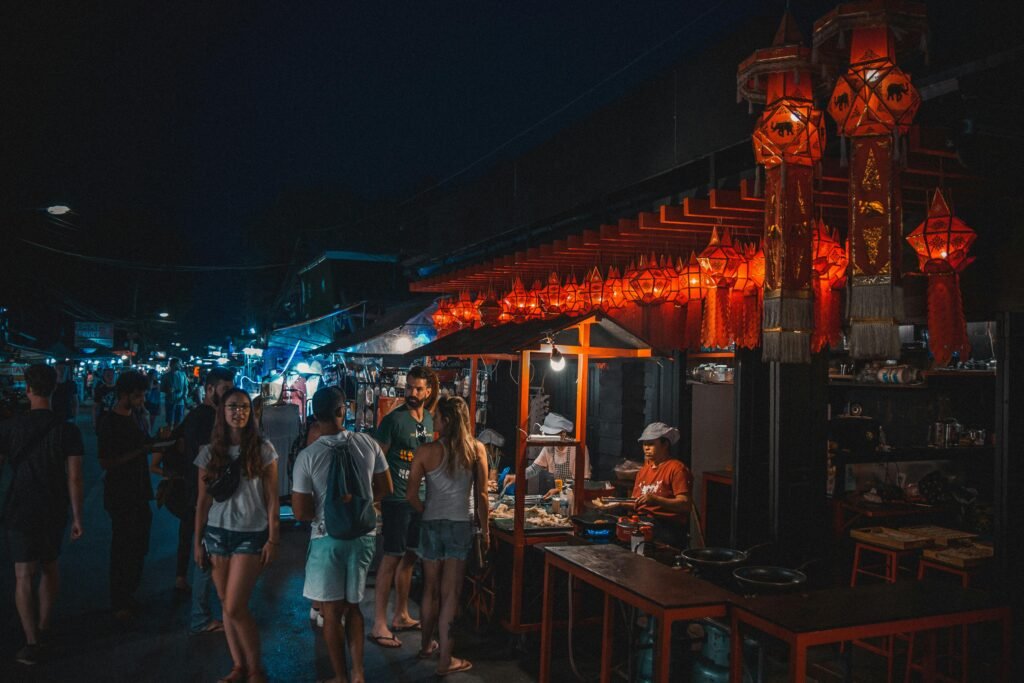
The deeper the bow, the more respect you convey. If someone wais you, make sure to return the gesture appropriately. If you’re not sure which variation to use, a simple wai with a smile is always appreciated. The wai is more than just a greeting; it reflects core Thai values of respect, courtesy, and honoring hierarchy.
By incorporating the wai into your interactions, you demonstrate cultural sensitivity and appreciation for Thai customs.
Titles are an important part of Thai culture, reflecting social hierarchy, respect, and profession. As a traveler, understanding these titles can help you interact with other people and avoid any unintentional faux pas.
– The most widely used Thai title is “Khun”which is used to address anyone you don’t know well or someone of similar social standing, including Ms., Mr., and Mx.
– “Nai” is a title used before the given name of men, similar to Mr.
– “Nang” is a title used before the given name of unmarried women, similar to Ms.
– “Sai” is a more formal version of “Nang” and is used before the given name of unmarried women.
– “Phra” is a title that precedes the Buddhist name of a monk. It’s a mark of deep respect, so monks should be addressed as “Phra” followed by their monastic name.
– “Chao” is a higher title used before the name of senior or highly respected monks.
– “Ajarn” is a title used for teachers and lecturers, similar to Professor.
– “Achan” is used for teachers at a lower level, similar to Instructors.
– “Puen” translates to “doctor,” but it’s used for medical doctors as well as people with PhDs.
– “Khun” + Last Name is a more formal way to address someone, and it’s becoming increasingly common in business settings.
– “Your Excellency” is used to address people of very high standing, government officials, or ambassadors.
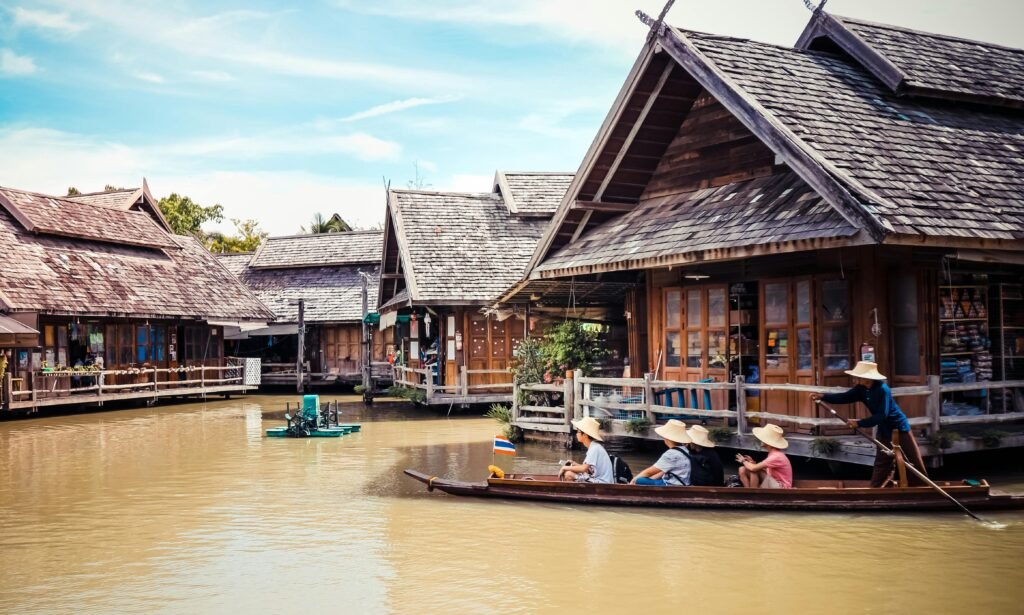
Things to Remember:
– It’s preferable to err on the side of showing more respect by using a respectful title.
– “Khun” is a safe default option when you’re unsure of which title to use.
– Titles are usually followed by the person’s first name, not their last name.
– Proper pronunciation of titles is important in avoiding any misunderstandings.
– Appropriately using Thai titles demonstrates respect for the culture and creates a better impression during your interactions with the locals.
Religion and Spirituality:
Buddhism’s Profound Influence:
The Roots of Faith: Buddhism first arrived in Thailand around the 2nd century BCE, gradually establishing itself and thriving under royal patronage.
Kings were regarded as Dharma protectors, responsible for upholding Buddhist principles and supporting the religion’s growth. This relationship between monarchy and religion continues to impact Thai society today.
A Nation Steeped in Buddhist Values: Thai culture deeply embodies the core tenets of Buddhism, such as the Four Noble Truths, the Eightfold Path, and the concept of karma.
Here are some examples of how these principles manifest: –
Merit-Making: Thais aim to accumulate merit (good karma) by performing acts of generosity, such as offering alms to monks or contributing to temple upkeep. This belief system shapes everyday life and social interactions.
Monks are highly respected and are considered spiritual guides on the path to enlightenment. Thais show their respect by performing the wai gesture and offering daily alms.
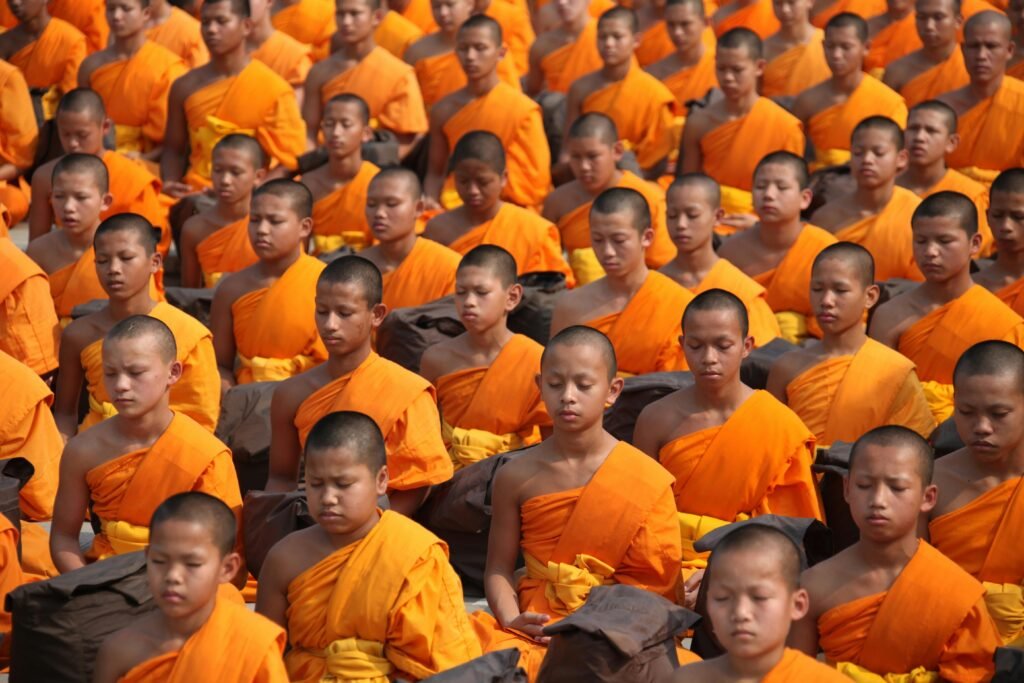
Non-violence and compassion are highly valued in Thai society, reflecting the Buddhist principle of ahimsa.
The Thai people embrace the concept of impermanence and detachment, as they find joy in life’s simple pleasures without clinging to possessions or outcomes.
The influence of Buddhism in Thai life extends beyond beliefs and is present in various aspects of their culture. Thailand is home to over 30,000 temples, or wats, which serve as places of worship, meditation, and community gatherings, embodying Buddhist principles with their serene atmosphere and intricate architecture.
Buddhist themes and stories are prevalent in Thai art forms, from sculptures and paintings depicting Buddha’s life to classical literature steeped in Buddhist philosophy.
Many Thai festivals have Buddhist roots, such as Loy Krathong, where offerings are made to water spirits, and Songkran, the Thai New Year, which involves merit-making and cleansing rituals.
Thailand’s cultural tapestry is enriched by its connection to Buddhism, and exploring it will reveal unique experiences and hidden gems.
Animism and spirit houses are also part of Thailand’s rich cultural tapestry and complement the vibrant threads of Buddhism.
In Thailand, alongside Buddhism, there exists another ancient belief system called animism, which holds that spirits inhabit and animate all things, from towering trees to rushing rivers. This unique blend of beliefs is reflected in the tradition of spirit houses.
In animistic beliefs, spirits are thought to be everywhere, both benevolent and mischievous, and believed to influence daily life.
Appeasing them is seen as essential for good fortune and protection. Spirit houses, miniature shrines that look like Thai homes, are a common sight throughout Thailand, outside homes, businesses, and even government buildings.
These structures are believed to be abodes for wandering spirits, offering them a place to reside and receive offerings.
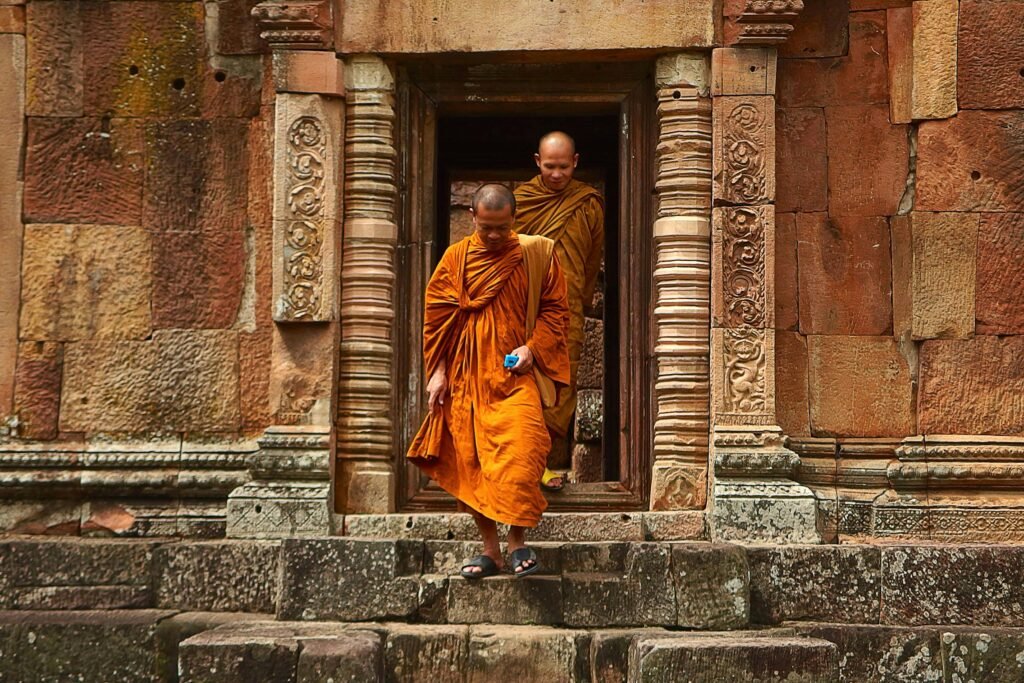
Thais believe that keeping the spirits content brings good luck and wards off misfortune. Therefore, offerings of food, water, flowers, and incense are placed in the spirit house to appease the spirits.
By taking care of these unseen inhabitants, people hope to cultivate harmony and avoid any potential disturbances. The design of spirit houses reflects the fusion of animism and Buddhism.
While some are simple wooden structures, others are more elaborate and reflect Buddhist architectural influences.
This harmonious coexistence reflects the adaptability and tolerance inherent in Thai culture. While witnessing animistic rituals directly might be rare, spirit houses serve as a constant reminder of this ancient belief system.
Visitors should avoid touching or disrespecting spirit houses to show respect.
Observing locals making offerings and showing appreciation for the cultural significance is key.
If you decide to take photos, be sure to do so from a respectful distance.
Understanding animism and spirit houses can help you appreciate the multifaceted nature of Thai culture better; it’s a reminder that sometimes, respecting the unseen is just as important as what we can readily perceive.
When it comes to social etiquette, there are some essential tips to keep in mind while in Thailand. Thailand is known as the “Land of Smiles” because of its friendly locals and warm hospitality.
Understanding basic etiquette can help you immerse yourself in the culture and ensure a smooth experience.
The Wai is a graceful gesture with palms pressed together that’s a cornerstone of Thai etiquette.
You can use the Wai for greetings, thanks, and apologies. The greater the respect you want to show, the higher the hands, and the deeper the bow should be. Politeness is highly valued in Thai culture, and people generally avoid raising their voices.
Speak softly, and address elders and people of higher standing with titles like “Khun” (Mr./Ms.) followed by their first name. Monks deserve even greater respect and are addressed as “Phra” or “Chao.”
Mind your body language while in Thailand and avoid public displays of affection, which are generally frowned upon.
Feet are considered unclean, so avoid pointing them at someone. Sit properly, especially in temples, and don’t cross your legs in front of someone you respect.

When visiting temples, dress modestly (shoulders and knees covered), remove your shoes before entering, and speak softly.
Avoid pointing or climbing on religious structures. Haggling is expected at markets, but do so politely with a smile.
Be respectful of the vendor’s time and avoid getting frustrated. Tipping isn’t mandatory in Thailand, but it’s becoming increasingly common, especially in tourist areas. A small tip for good service is always appreciated.
When taking photographs in Thailand, be sure to ask permission before photographing people, especially monks.
Unless there’s a clear sign permitting it, avoid taking pictures of ceremonies or religious objects. Be patient while in Thailand, as things typically move at a slower pace.
Embrace the laid-back attitude, known as “Sanuk,” and avoid becoming frustrated by any delays.
By following these simple guidelines, you will demonstrate respect for Thai culture and create a more positive experience for yourself and those around you.
Remember that a genuine smile and polite demeanor are universally understood gestures of courtesy.
To navigate Thailand respectfully, it’s important to understand the significance of the head and feet in Thai culture. The concept of respect goes beyond polite greetings and proper titles.
In Thai culture, the head is considered the most sacred part of the body as it houses the “khwan,” a spiritual essence believed to reside within each person. Avoid touching someone’s head, even a child’s, and never pat or ruffle someone’s hair.
When seated, be sure never to place your head above someone you respect, especially an elder or a monk.
The feet are considered the lowest and “unclean” part of the body in Thai culture due to their proximity to the ground. Pointing your feet at someone, especially a Buddha statue or a person of higher social standing, is considered a major insult. When seated, avoid crossing your legs in a way that exposes your soles to others. Instead, sit with your ankles together or your feet tucked under your body.
In many places in Thailand, it’s customary to remove your shoes when entering a temple, home, or even some restaurants as a sign of respect for the space.
When handing someone an object, use both hands and hold it slightly above your waist to show respect. If someone wai (a respectful gesture with palms pressed together), return the wai appropriately.
By understanding these concepts, you can avoid unintentional disrespect and navigate social interactions with ease. Keep in mind that a little cultural awareness can go a long way in showing respect for the Thai way of life.
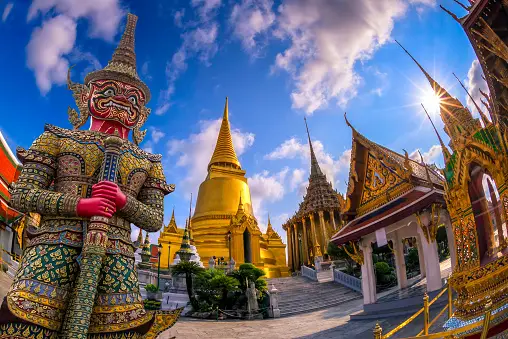
A smile goes a long way: A genuine smile and respectful behavior are universally understood gestures of kindness.
By understanding and respecting the Thai cult:
A Guide to Public Displays of Affection in Thailand:
Keeping it Cool Thailand is known as the “Land of Smiles” due to its amazing scenery, vibrant culture, and warm hospitality. However, as with any other destination, it is crucial to comprehend the social norms surrounding public displays of affection (PDA) to ensure a respectful and enjoyable experience.
A Culture of Courtesy: Thai culture gives importance to politeness, respect, and maintaining social harmony. Public displays of affection, especially those that are overly passionate, are generally considered impolite.
However, this does not mean that you cannot show your affection for your travel partner at all, but it is best to keep it more subdued. Acceptable Gestures:
Holding hands while walking is widely acceptable in Thailand. A quick peck on the cheek or a hug while greeting or parting is unlikely to cause offense.
However, it is best to avoid extended embraces, deep kissing, or anything overly passionate in public spaces.
Places to be Mindful: Temples: These are sacred spaces, so it is best to avoid even holding hands. Dress modestly and maintain a respectful demeanor.
Traditional Restaurants: While some tourist areas may be more relaxed, it is always best to err on the side of caution in more traditional settings.
Public Transportation: Buses, trains, and other public areas are not ideal spots for PDAs. Be mindful of your fellow passengers.
Alternative Ways to Show You Care:
Focus on creating shared experiences:
Explore the beauty of Thailand together, try new things, and enjoy your time as a couple.
Non-verbal cues: A gentle touch on the arm, a knowing smile, or sharing a laugh can all convey affection without being too public.
Romantic dinners: Enjoy a candlelit dinner at a nice restaurant. This allows for a more private and intimate setting.
Remember:
Observe Other Couples: See how Thai couples interact in public to gauge what is considered appropriate. Use your best judgment: If you are unsure, it is always better to err on the side of caution. As a reminder, the original text was: “an enjoyable travel experience for yourself and those around you. Thailand offers a wealth of experiences to create lasting memories, so focus on exploring the wonders of the country and enjoying your time together.
Unique Customs and Traditions:
Witnessing Merit and Reverence:
The Alluring Ritual of Monk Almsgiving in Thailand The dawn breaks over Thailand, painting the sky with soft hues of orange and pink. As the world awakens, a mesmerizing spectacle unfolds – the daily ritual of monk almsgiving.
This cherished tradition offers a glimpse into the heart of Thai culture, where reverence for Buddhism beautifully intertwines with the concept of merit-making.
The Essence of the Ritual:
Offering for Merit: Almsgiving, known as “Wat Phra Kathin” or “Tak Bat,” is a way for Thais to earn merit (good karma) by offering food to monks.
A Reciprocal Act: It’s not just charity. Monks, who have dedicated their lives to spiritual pursuits, bestow blessings upon those who offer them alms. This reciprocal act reinforces the connection between the monastic community and the laity.
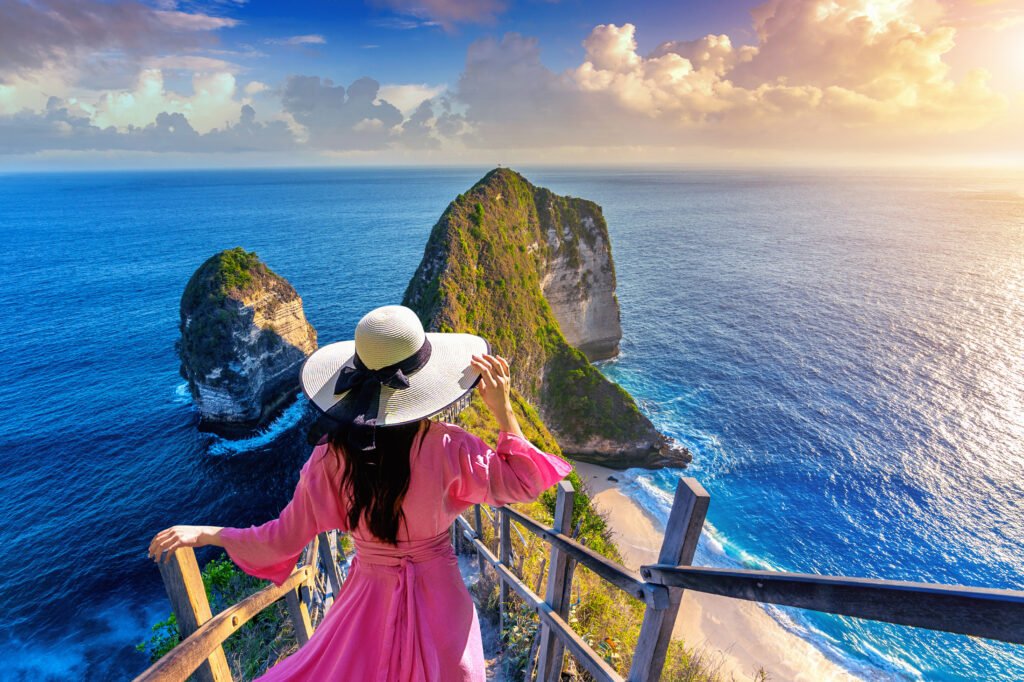
Participating in the Ritual:
Early Start: The ceremony takes place very early in the morning, typically between 6:00 AM and 8:00 AM. Arrive at the designated location before dawn to witness the procession.
Respectful Attire: Dress modestly, with shoulders and knees covered. Avoid loud colors or overly revealing clothing.
Offering Alms: Purchase pre-packaged alms from vendors near the temple. These typically contain cooked rice, fruits, or vegetarian dishes.
The Procession: A line of saffron-robed monks walks silently, holding their alms bowls. As they approach, kneel respectfully on a mat provided or sit on your heels with your head bowed slightly.
Offering the Food: When a monk reaches you, gently place the alms offering in their bowl without making physical contact.
Receiving Blessings: The monks may chant a short blessing or offer a wai (a gesture of respect) in return.
Cultural Significance:
A-Pillar of Buddhism: Almsgiving is a core tenet of Theravada Buddhism practiced in Thailand. It reflects the importance of generosity, selflessness, and respect for the monastic order.
A Window into Thai Culture: Witnessing this ritual allows you to experience Thai culture firsthand. It highlights the deep reverence for Buddhism and the importance of merit-making in daily life.” Here is the reworded text:
Thailand is a great country to visit for an enjoyable travel experience. There are plenty of things to see and do that can create lasting memories, so make sure to take the time to explore and enjoy everything with your companions.
One of the unique customs and traditions worth experiencing in Thailand is the ritual of monk almsgiving. This ritual takes place at dawn and showcases how Thai culture values Buddhism and the concept of merit-making.
The ritual of almsgiving, also known as “Wat Phra Kathin” or “Tak Bat,” is a way for Thai people to earn good karma by offering food to the monks. It is not just charity, though.
Monks also bestow blessings on those who offer them alms, creating a reciprocal relationship between the monastic community and the people.
To participate in the ritual of almsgiving, you need to arrive at the designated location early in the morning, before 6:00 AM or 8:00 AM. It is also important to dress modestly, with your shoulders and knees covered, and avoid wearing loud colors or revealing clothing.
Pre-packaged alms are available for purchase from vendors near the temple. These usually contain cooked rice, fruits, or vegetarian dishes.
During the procession, a line of saffron-robed monks walks silently, holding their alms bowls. When a monk approaches, kneel on a mat or sit on your heels with your head bowed slightly, and gently place the alms offering in their bowl without making physical contact.
The monks may chant a short blessing or offer a wai (a gesture of respect) in return. Almsgiving is a core tenet of Theravada Buddhism, which is widely practiced in Thailand. It reflects the values of generosity, selflessness, and respect for the monastic order.
Witnessing this ritual allows you to experience Thai culture firsthand, and it highlights the importance of merit-making in daily life.
Please find below the requested reworded text: Respectful Observation: To avoid disruption during the ceremony, kindly maintain a respectful silence, and refrain from using flash photography.
If you do not wish to participate, you can still observe the procession from a distance while being respectful. Remember to dress modestly, as previously advised, to show respect. Participating in the tradition of Monk almsgiving can be an emotional and powerful experience that can help you gain a deeper understanding of Thai culture and Buddhist beliefs.
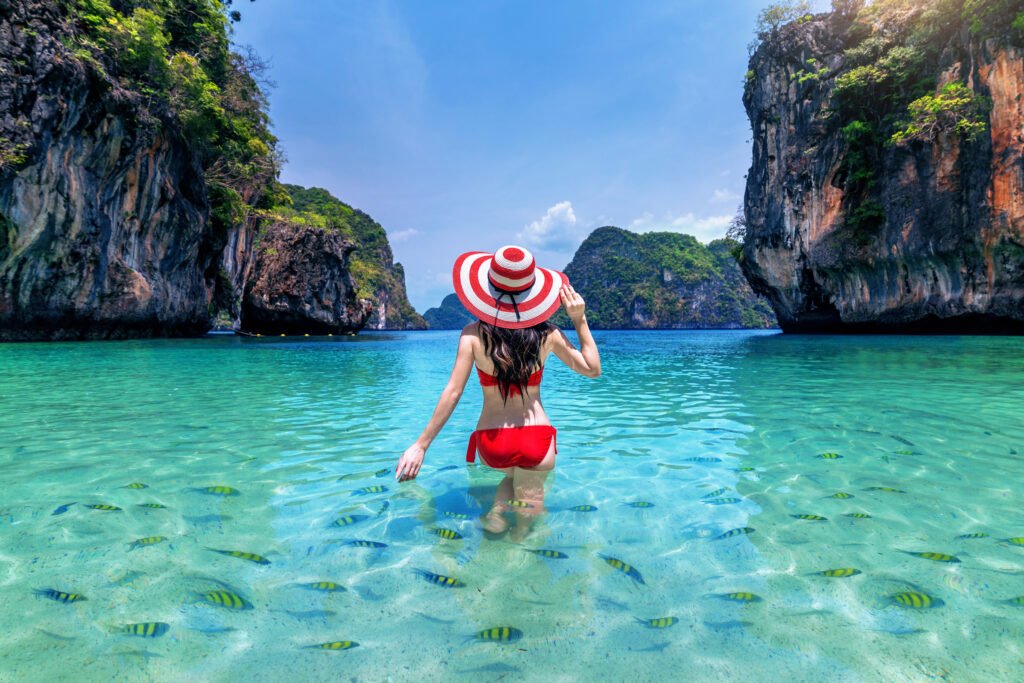
This offers a unique opportunity to be part of something truly special and create a lasting memory of your time in the Land of Smiles.
Songkran: Thailand’s Wild and Wonderful Water Festival Songkran, also known as the Thai New Year, is an energetic, vibrant, and one-of-a-kind festival.
The festival is held annually in mid-April, serving as a time for families to reunite, cleanse away misfortune, and welcome a fresh start with a joyous splash!
A Celebration Steeped in Tradition: Songkran’s date is determined by the lunar calendar, coinciding with the sun’s movement into the zodiac sign Aries, signifying a shift in the astrological year.
Water plays a central role in Songkran festivities, symbolizing the washing away of bad luck and negativity from the past year. People drench each other with water, creating a joyous and chaotic atmosphere.
The Three Days of Songkran: The 13th of April marks the official start of Songkran, known as Wan Nao, where people visit temples to make merit, cleanse Buddha statues with fragrant water, and prepare for the water fights to come.
The 14th of April, known as Wan Songkran (Thai New Year’s Day), is the real fun day, where the streets transform into a massive water battlefield. People arm themselves with water guns, buckets, and hoses, engaging in friendly (and sometimes fierce) water fights.
It’s a time for laughter, merriment, and letting loose. The 15th of April, known as Wan Thaloeng Sok, signifies the official end of Songkran.
Families gather for merit-making ceremonies and pay respect to elders. It’s a more subdued day compared to the previous two.
Joining the Songkran Festivities: If you are visiting Thailand during Songkran, be prepared to get wet!
It’s important to pack light, quick-drying clothes, and a waterproof bag for your valuables. While the water fights are meant to be fun, please respect others and avoid targeting those who are trying to avoid getting soaked, such as those carrying valuables or dressed in formal attire.
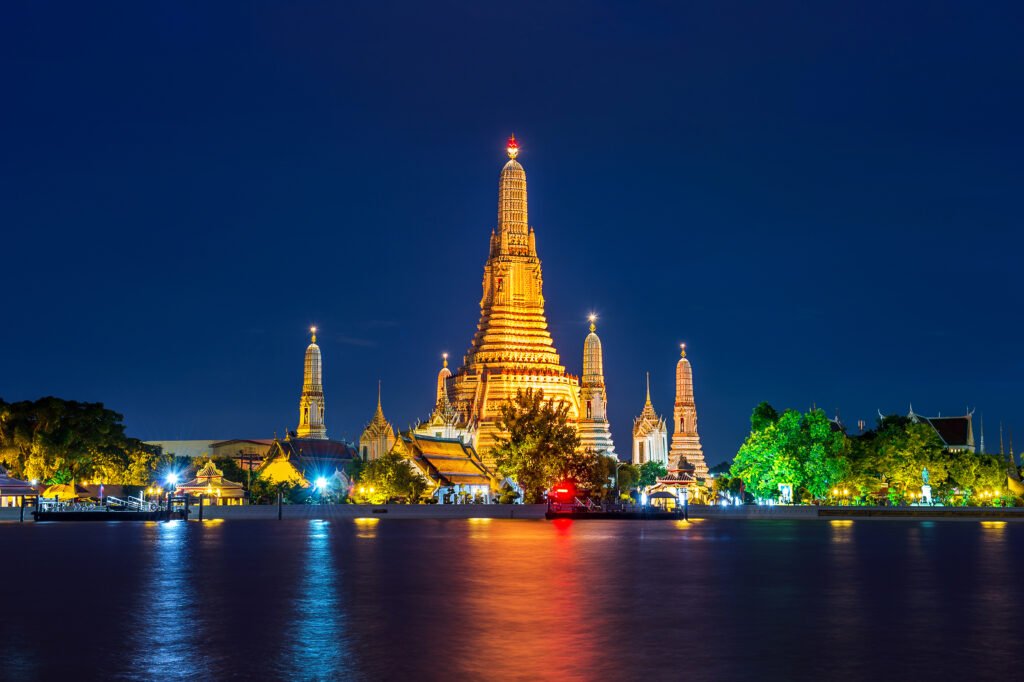
Use clean water and avoid throwing ice or anything harmful while engaging in the water fights.
Water guns, buckets, and colorful sarongs are readily available for purchase during Songkran.
Carry a waterproof phone case and wear sunscreen, even if it’s cloudy, to protect yourself. Beyond the Water Fights: During Songkran, many towns hold beauty pageants, adding to the festive atmosphere.
– Traditional Thai games such as “sepak takraw” are often played in public spaces during Songkran. – While water fights are the main attraction, visiting temples during Wan Nao
and Wan Thaloeng Sok to participation in merit-making ceremonies offers a glimpse into the more traditional aspects of the festival.
– Songkran is a celebration that embodies the essence of Thai culture, representing renewal, cleansing, and community spirit. Be sure to bring your playful spirit, embrace the water, and get ready to experience the “Wet” New Year Thai style!
– Loy Krathong, also known as the “Festival of Lights,” is a captivating event that takes place across Thailand’s rivers, lakes, and canals as the full moon illuminates the night sky.
– Loy Krathong’s origins can be traced back to ancient animistic beliefs and Hindu harvest festivals, and it’s a time to pay respect to the water spirits and give thanks for a bountiful harvest.
– Over time, the festival has incorporated Buddhist traditions, and people now use the Krathong, a beautifully decorated floating raft, to symbolically let go of negativity or past transgressions.
– Krathongs are traditionally made from folded banana leaves decorated with flowers, candles, and incense sticks to create a visually stunning offering, but modern variations made from bread promote eco-friendliness.
– Loy Krathong takes place on the full moon of the twelfth lunar month, typically in November, providing the perfect backdrop for the floating lanterns.
– As you release your Krathong onto the water, make a wish for good luck, prosperity, or letting go of negativity while the candle flame guides your wishes towards the heavens. Use this moment to reflect and appreciate the beauty of the festival.
Experiencing Loy Krathong: – Festivities are held across Thailand where in Chiang Mai, the celebrations are particularly elaborate with beauty contests to select the “Krathong Queen.”
– The vibrant atmosphere is enhanced by cultural performances featuring traditional Thai dances, music, and lantern parades.
– It is important to participate respectfully by using biodegradable materials for your Krathong and avoiding littering the waterways.
– Loy Krathong is a cultural experience that reflects Thailand’s deep respect for nature and its spiritual beliefs, and it is more than just a beautiful spectacle. Witnessing this festival allows you to connect with the heart and soul of Thailand and create memories that will last a lifetime.
– To enrich your Thai experience, it is essential to understand these cultural nuances. By respecting local customs and traditions, you’ll gain a deeper appreciation for the warmth and hospitality that Thailand is so famous for. Thai cuisine is renowned for its vibrant flavors, fragrant curries, and refreshing noodle dishes.
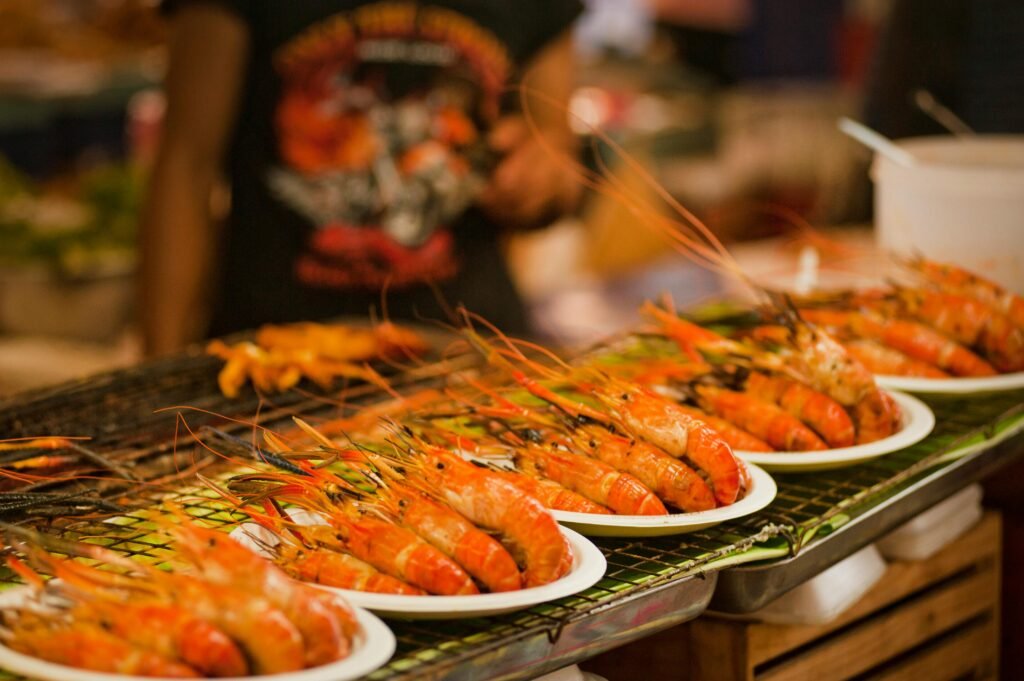
Below are some must-try dishes on your Thailand food adventure: –
Pad Thai is Thailand’s national dish, a stir-fried rice noodle dish with egg, vegetables, and your choice of protein (usually chicken, shrimp, pork, or tofu). Typically seasoned with a tamarind sauce, fish sauce, palm sugar, and chili flakes, it offers a delightful balance of sweet, salty, sour, and spicy flavors.
– Som Tam (Green Papaya Salad) is a refreshing salad that mixes shredded green papaya, carrots, tomatoes, green beans, peanuts, and shrimp (optional). It’s dressed with a tangy lime sauce with fish sauce, palm sugar, and chilies, offering a delightful combination of sweet and tangy flavors.
– Gaeng Keow Wan Gai (Green Curry) is a flavorful curry that’s a must-try for green curry lovers. Aromatic green curry paste, made with chilies, lemongrass, kaffir lime leaves, galangal, and herbs, is simmered in coconut milk with chicken, vegetables (like bamboo shoots and eggplant), and Thai basil leaves. The result is a creamy, flavorful curry with a delightful balance of spice and coconut cream.
– Tom Yum Goong is a spicy and sour shrimp soup that’s a quintessential Thai dish. The aromatic broth is infused with lemongrass, kaffir lime leaves, galangal, and chilies, and packed with shrimp, mushrooms, tomatoes, and cilantro. Squeeze in some fresh lime juice for an extra flavor boost!
– Khao Pad (Thai Fried Rice) is a versatile dish that is a staple in Thai cuisine. Cooked rice is stir-fried with eggs, vegetables, meat (chicken, pork, or shrimp), and seasoned with fish sauce, soy sauce, oyster sauce, and chilies. You’ll often find variations with pineapple, crab, or wrapped in an omelette.
– Massaman Curry is a unique curry known for its rich and complex flavor profile. Muslim influences are evident in the use of spices like cumin, cardamom, and cinnamon. Slow-cooked with chicken, potatoes, onions, peanuts, and simmered in a creamy coconut milk base, Massaman curry offers a depth of flavor that will tantalize your taste buds.
Experiencing Loy Krathong: – In Thailand, Loy Krathong is celebrated with festivities, and in Chiang Mai, the celebrations are particularly elaborate, including beauty contests to select the “Krathong Queen.”
– The cultural experience is enhanced by traditional Thai dances, music, and lantern parades that add to the vibrant atmosphere.
– To participate respectfully, it is important to use biodegradable materials for the Krathong and avoid littering the waterways.
– Loy Krathong is an experience that reflects Thailand’s deep respect for nature and spiritual beliefs, and it is more than just a beautiful spectacle. By witnessing this festival, you can connect with the heart and soul of Thailand and create memories that will last a lifetime.
– To have a more enriched Thai experience, it is essential to understand these cultural nuances. By respecting local customs and traditions, you’ll gain a deeper appreciation for the warmth and hospitality that Thailand is so famous for.
Thai cuisine is renowned for its vibrant flavors, fragrant curries, and refreshing noodle dishes. Here are some must
-try dishes on your Thailand food adventure:
Thailand’s national dish is Pad Thai, a stir-fried rice noodle dish with egg, vegetables, and your choice of protein (usually chicken, shrimp, pork, or tofu). It’s seasoned with a tamarind sauce, fish sauce, palm sugar, and chili flakes, offering a delightful balance of sweet, salty, sour, and spicy flavors.
– Som Tam (Green Papaya Salad) is a refreshing salad that combines shredded green papaya, carrots, tomatoes, green beans, peanuts, and shrimp (optional).
It’s dressed with a tangy lime sauce with fish sauce, palm sugar, and chilies, offering a delightful combination of sweet and tangy flavors.
– Gaeng Keow Wan Gai (Green Curry) is a flavorful curry that’s a must-try for green curry lovers. Aromatic green curry paste, made with chilies, lemongrass, kaffir lime leaves, galangal, and herbs, is simmered in coconut milk with chicken, vegetables (like bamboo shoots and eggplant), and Thai basil leaves.
The result is a creamy, flavorful curry with a delightful balance of spice and coconut cream.
– Tom Yum Goong is a quintessential Thai dish, a spicy and sour shrimp soup. The aromatic broth is infused with lemongrass, kaffir lime leaves, galangal, and chilies and packed with shrimp, mushrooms, tomatoes, and cilantro. Squeezing in some fresh lime juice enhances the flavor.
– Thai Fried Rice (Khao Pad) is a versatile dish that is a staple in Thai cuisine. Cooked rice is stir-fried with eggs, vegetables, and meat (chicken, pork, or shrimp), and seasoned with fish sauce, soy sauce, oyster sauce, and chilies. Variations with pineapple, crab, or wrapped in an omelet are often found.
– Massaman Curry, a unique curry known for its rich and complex flavor profile, is slow-cooked with chicken, potatoes, onions, and peanuts, and simmered in a creamy coconut milk base. Muslim influences are evident in the use of spices like cumin, cardamom, and cinnamon, offering a depth of flavor that will tantalize your taste buds.
Mango Sticky Rice (Khao Niao Mamuang) is a dessert that is sweet and refreshing, making it a perfect way to end a Thai meal. The glutinous rice is steamed and cooked with palm sugar and coconut milk, giving it a slightly sweet and sticky texture. It is usually served with ripe mango slices and a sweet coconut cream sauce that is drizzled on top.
Thai cuisine is known for its emphasis on fresh ingredients, bold flavors, and fragrant spices, making it a true culinary adventure for the senses.
There are many delicious dishes to be explored in Thailand, and these are just a few examples.
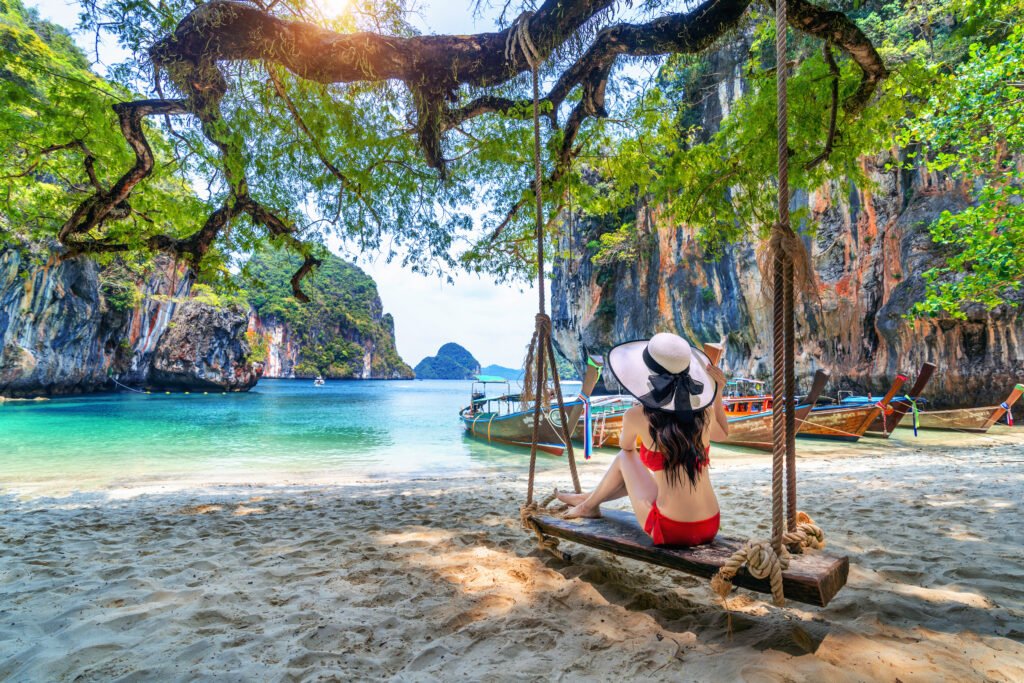
Thailand is a country located in Southeast Asia that is famous for its stunning beaches, rich culture, and delicious food. Bangkok is the capital and most populous city of Thailand, officially known as Krung Thep Maha Nakhon and colloquially as Krung Thep.
It occupies 1,568.7 square kilometers in the Chao Phraya River delta in central Thailand and has an estimated population of 9.0 million as of 2021, which is 13% of the country’s population.
The surrounding Bangkok Metropolitan Region has over 17.4 million people (25% of the country’s population), making Bangkok an extreme primate city that dwarfs Thailand’s other urban centers in both size and importance to the national economy.
The Grand Palace is Bangkok’s most famous landmark and was the official residence of the Siamese royal family for over 150 years. It is a complex of buildings that includes halls of audience, throne halls, and royal living quarters.
The Emerald Buddha, which is a highly revered Buddha statue carved from jade, is one of the most popular attractions within the Grand Palace complex. Wat Pho, also known as the Temple of the Reclining Buddha, is one of the oldest and largest temples in Bangkok.
The giant reclining Buddha statue, which is 46 meters long and 15 meters high, is a major attraction at the temple. In addition to the Buddha statues and religious buildings, the temple complex also houses a traditional Thai massage school There are various Buddha statues and religious structures.
– Wat Arun, or the Temple of Dawn, can be found on the western bank of the Chao Phraya River. The temple is well-known for its prang, an ornate Khmer-style spire decorated with vibrant porcelain tiles.
Wat Arun is a stunning sight, particularly during sunrise when the porcelain tiles reflect the sun’s rays.
– Wat Phra Kaew, also called the Temple of the Emerald Buddha, is located inside the Grand Palace complex. It is the most sacred temple in Thailand and is home to the Emerald Buddha, a highly respected Buddha statue carved from jade.
The temple complex exemplifies Thai architecture and is a must-see for any Bangkok visitor.
– The Chao Phraya River is the heart of Bangkok. It is a significant transportation route lined with historic landmarks, temples, and shops. Travelers can take a boat ride down the river to explore Bangkok’s sights or visit some of the city’s khlongs or canals.
– Ayutthaya Historical Park is a UNESCO World Heritage Site that showcases the ruins of Siam’s ancient capital. The park includes the ruins of many temples, palaces, and monasteries. It is a fascinating destination that provides insights into Thailand’s history.
– Bangkok is a city full of attractions for visitors. With its fascinating history, stunning temples, and mouth-watering cuisine, Bangkok is a city that will leave a lasting impression on visitors.
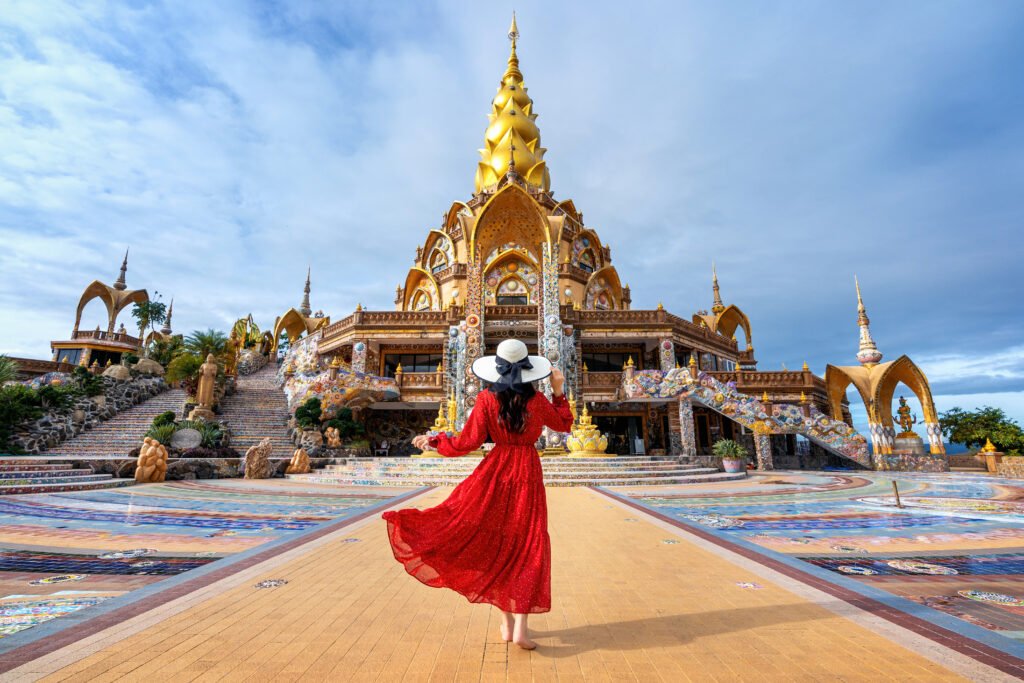
– Chiang Mai is situated in the mountainous region of northern Thailand. It is the largest city in the region and a well-liked tourist destination famous for its natural beauty, rich cultural heritage, and laid-back vibe.
The city is renowned for its ancient temples, vibrant markets, and thrilling outdoor activities.Chiang Mai has over 300 temples within its city walls, each with its own unique architectural style and history.
These enchanting temples include Wat Phra That Doi Suthep, which is perched atop Doi Suthep mountain and offers panoramic views of the city, as well as Wat Chiang Man, the oldest temple in the city that is said to enshrine a tooth of the Buddha. Wat Phra Singh boasts intricate latticework windows, and the gleaming silver chedi of Wat Chiang Man is truly amazing.
Chiang Mai’s night markets are thriving and bustling with activity. Thapae Walking Street is a haven for handicrafts, souvenirs, and street food, while Chiang Mai Night Bazaar offers a wider selection of goods, including clothing, electronics, local artwork, and homeware.
If you’re looking for a more traditional and cultural experience, Saturday Night Walking Street is the place to go, featuring local artisans selling their crafts and delicious northern Thai specialties.
Chiang Mai’s elephant sanctuaries provide a more ethical experience for visitors. These sanctuaries offer a safe haven for rescued elephants to heal and thrive.
You can observe the elephants in their natural habitat, learn about their plight, and even volunteer to help care for them.
Whether you’re a history buff, a nature lover, or a thrill-seeker, Chiang Mai has something for everyone. You can explore captivating temples, vibrant markets, delicious food, and exciting activities that are sure to leave you with unforgettable memories.
Phuket is Thailand’s largest island and a popular beach paradise in the Andaman Sea. Renowned for its stunning beaches, crystal-clear waters, and lush rainforests, Phuket offers a plethora of experiences for travelers seeking relaxation, adventure, and cultural immersion.
Krabi is another popular beach destination in southern Thailand, known for its stunning limestone cliffs, caves, and beaches.
Railay Beach is a popular spot for rock climbing, while Ao Nang Beach is a great place to relax and soak up the sun.
You can also take a boat trip to the nearby Phi Phi Islands or explore the Tham Luang Nang Non cave, where a group of youth soccer players were famously rescued in 2018. Ayutthaya, the former capital of Siam and now a UNESCO World Heritage Site, is home to the ruins of many temples, such as Wat Mahathat, Wat Phra Si Sanphet, and Wat Chai Watthanaram.
The Ayutthaya Historical Park is another attraction that features the ruins of the royal palace and other government buildings. Kanchanaburi, a province in western Thailand, is home to the Bridge on the River Kwai, which was built by prisoners of war during World War II. You can also visit the Erawan National Park, which is home to seven waterfalls, or the Hellfire Pass, a section of the Death Railway that was built by forced labor.
Here are some excellent locations to explore in Thailand. With its stunning beaches, delicious cuisine, and diverse culture, Thailand is a place that has something to offer for everyone.
Tips for a hassle-free and pleasant trip to Thailand: Planning and Booking:
· Seasonal Preparation: Thailand experiences a tropical climate with a rainy season (approximately July to October) and a dry season (November to April).
The months of May, June, and November have pleasant weather conditions with fewer crowds.
· Required Documents and Visas: Prior research on visa requirements based on your nationality is a must. Ensure that your passport is valid for at least six months. Additionally, consider obtaining travel insurance to tackle unexpected situations.
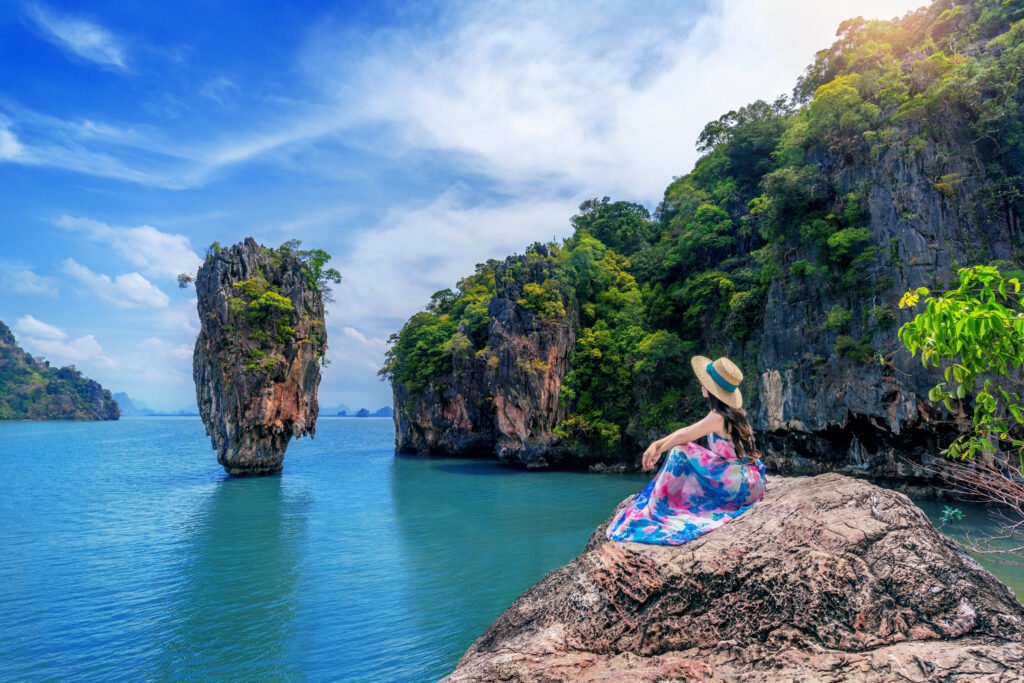
· Booking Flights and Accommodation:
To avoid last-minute hassles, it is advisable to book your flights in advance, especially during the peak season. Research various accommodation options based on your preferences and budget, such as beachfront resorts, city-center hotels, and charming guesthouses.
Essentials to Pack:
· Lightweight and Breathable Clothes: Thailand’s climate is hot and humid. Pack loose-fitting clothes to stay comfortable.
· Respectful Attire: While visiting temples, it is best to cover your shoulders and knees to adhere to cultural norms. Pack a scarf or sarong to cover yourself easily.
· Sun Protection: Protect yourself from the tropical sun with sunscreen, hats, and sunglasses.
· Comfortable Footwear: Expect to do some walking, especially when exploring temples and markets, so pack comfortable walking shoes.
· Insect Repellent: Dengue fever is a concern, so pack insect repellent containing DEET.
· Cash: While credit cards are accepted in tourist areas, it is useful to carry cash for smaller shops and local transportation. You will find ATMs widely available.
Cultural Considerations:
· Respect Buddhist Practices: Thailand is predominantly Buddhist. Dress modestly when visiting temples, and avoid loud noises or disrespectful behavior.
· Bargaining: Bargaining is a common practice in markets. Do so politely and with a smile.
· Greetings: The traditional Thai greeting is a “wai,” which is a slight bow with your palms together.
Please find below the reworded version of the text:
– It’s a good idea to learn some basic Thai phrases such as “khob khun” (thank you) and “sawasdee” (hello).
– Although tipping is not a common practice in Thailand, it is appreciated to leave a small gratuity for exceptional service.
– To stay safe, be vigilant about scams. While they are rare, you should be careful of overly friendly strangers who offer unsolicited help.
– Keep your valuables secure, especially in crowded areas, to avoid becoming a victim of pickpocketing.
– To ensure food and water safety, stick to bottled water and avoid street food from unhygienic vendors. Instead, go for freshly cooked meals at restaurants with good reviews.
– Learning about local etiquette is a great way to enhance your experience and gain a deeper appreciation of Thai customs.
– Buying travel insurance can provide peace of mind in case of emergencies.
– It can be helpful to download offline maps on your phone for navigating unfamiliar areas.
– Be open to trying new things and experiencing Thai culture at its finest to make the most out of your adventure in the Land of Smiles. By following these tips, you can ensure a safe, enjoyable, and culturally enriching trip to Thailand!

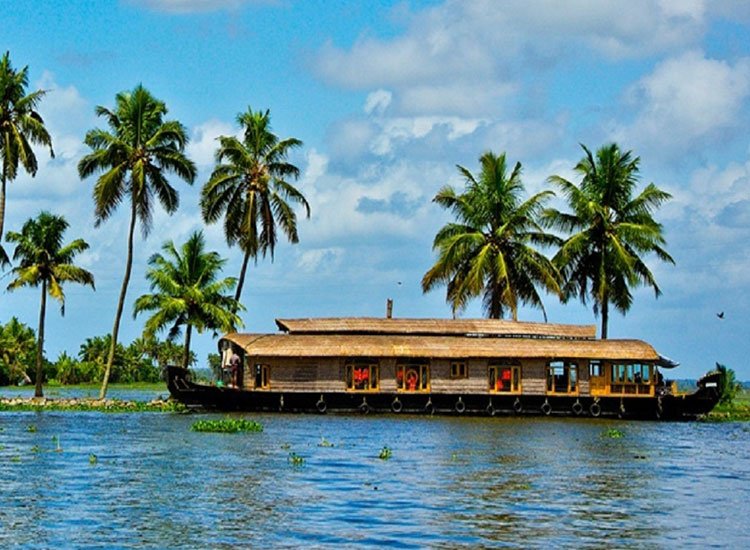
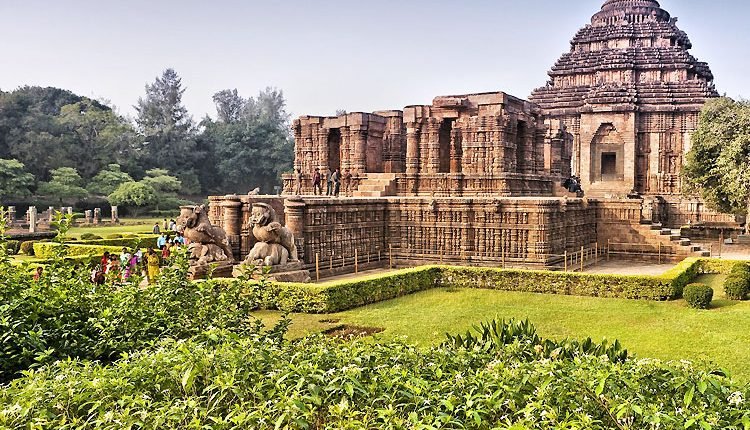
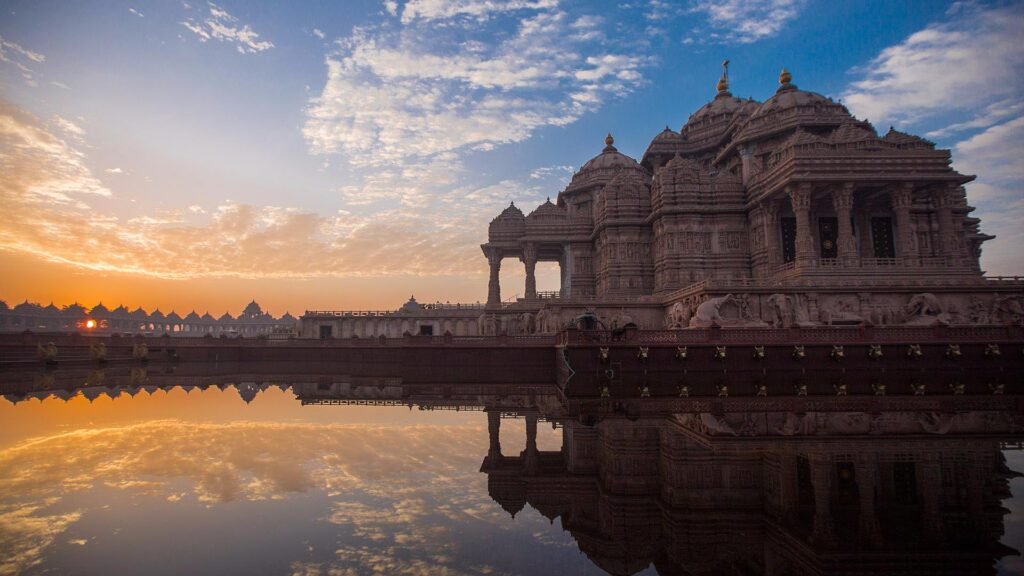
Hi there,
My name is Mike from Monkey Digital,
Allow me to present to you a lifetime revenue opportunity of 35%
That’s right, you can earn 35% of every order made by your affiliate for life.
Simply register with us, generate your affiliate links, and incorporate them on your website, and you are done. It takes only 5 minutes to set up everything, and the payouts are sent each month.
Click here to enroll with us today:
https://www.monkeydigital.org/affiliate-dashboard/
Think about it,
Every website owner requires the use of search engine optimization (SEO) for their website. This endeavor holds significant potential for both parties involved.
Thanks and regards
Mike Nathan
Monkey Digital
This service is perfect for boosting your local business’ visibility on the map in a specific location.
We provide Google Maps listing management, optimization, and promotion services that cover everything needed to rank in the Google 3-Pack.
More info:
https://www.speed-seo.net/ranking-in-the-maps-means-sales/
Thanks and Regards
Mike Aldridge
PS: Want a ONE-TIME comprehensive local plan that covers everything?
https://www.speed-seo.net/product/local-seo-bundle/
Hi there,
I have reviewed your domain in MOZ and have observed that you may benefit from an increase in authority.
Our solution guarantees you a high-quality domain authority score within a period of three months. This will increase your organic visibility and strengthen your website authority, thus making it stronger against Google updates.
Check out our deals for more details.
https://www.monkeydigital.co/domain-authority-plan/
NEW: Ahrefs Domain Rating
https://www.monkeydigital.co/ahrefs-seo/
Thanks and regards
Mike Ellington
Junte-se hoje a Organizacao Oficial dos Illuminati e torne-se rico em riqueza e conhecimento, esta e uma oportunidade de ouro, nao perca esta oportunidade, pois convidamos voce a fazer parte dos Illuminati e desfrutar dos inumeros beneficios a medida que voce se torna rico e rico nesta organizacao. Entre em contato com o Grao-Mestre no WhatsApp pelo numero +1(816)639-4143, nao perca esta oportunidade
Salutations! trendzlife.com
Did you know that it is possible to send letter absolutely legally? We suggest a new way of sending business proposals through contact forms.
As these messages are deemed important, the ones sent by Feedback Forms are not classified as spam.
We give you a chance to experience our service for free.
We are able to transmit up to 50,000 messages for you.
The cost of sending one million messages is $59.
This letter is automatically generated.
Please use the contact details below to get in touch with us.
Contact us.
Telegram – https://t.me/FeedbackFormEU
Skype live:feedbackform2019
WhatsApp +375259112693
WhatsApp https://wa.me/+375259112693
We only use chat for communication.
Hi
I have just verified your SEO on trendzlife.com for the ranking keywords and saw that your website could use a boost.
We will improve your ranks organically and safely, using only state of the art AI and whitehat methods, while providing monthly reports and outstanding support.
More info:
https://www.digital-x-press.com/unbeatable-seo/
Whatsapp us: https://wa.link/fqchim
Regards
Mike Phillips
Digital X SEO Experts
aut voluptatum hic omnis magni mollitia est vel explicabo occaecati sit perspiciatis consequatur voluptatum rerum consequuntur aperiam ad similique quos incidunt. sed et repudiandae qui consequuntur l
perspiciatis ullam in eos perspiciatis et dolor est ipsam sint temporibus in impedit sint sunt nihil laborum. numquam non sapiente reiciendis tempora nulla aut dolor esse sapiente voluptatem quia atqu
Стильные советы по выбору модных видов на каждый день.
Заметки профессионалов, события, все дропы и мероприятия.
https://ouptel.com/read-blog/43379